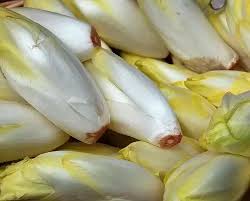Chicory, particularly forced chicory or “chicons,” is a delicious winter delicacy that has an interesting history. Similar to how many of our favorite foods were discovered by accident—like cornflakes, potato chips, or rhubarb—forced chicory emerged from a serendipitous event nearly 200 years ago. A Belgian farmer, who was growing chicory roots as a coffee substitute, noticed that some roots sprouted in his cellar. When he tasted the pale, tender leaves, he found them sweet and crunchy. This discovery led to the creation of chicons, a gourmet treat beloved for their creamy texture and crisp bite.
What Are Chicons?
Chicons are tightly packed, pale heads of chicory that resemble small cos lettuce. The process of forcing them, which involves placing mature chicory roots in a warm, dark environment to promote rapid growth, produces a sweeter and more tender vegetable than the naturally grown chicory. This practice is most commonly associated with the F1 hybrid “Witloof,” which is known for producing thick, fat chicons. Forced chicory is perfect for salads, adding a slightly bitter contrast when raw or a balanced sweetness when braised.
Growing Chicory
Before you can force chicory, you need to grow the roots. While chicory can be sown directly in the garden, a more efficient method is starting seeds in pots before transplanting. This helps maximize space in your garden and ensures healthy root development. Sowing chicory seeds into small pots (7.5 cm in diameter) at the end of spring or early summer is ideal. Avoid planting too early, as premature sowing can result in plants that go to seed and produce inferior roots.
Chicory prefers well-drained, sunny soil. Space plants about 15-20 cm apart in rows that are 30 cm apart. Once the seedlings develop strong taproots, transplant them to their final position in the garden. Chicory grows best in the summer, and proper care is essential to prevent weeds from competing with the plants.

Forcing Chicory
Forcing chicory roots begins in early winter. To start, trim the foliage down to about 2 cm above the root. At this point, you can either force individual roots as needed or dig up and store the entire crop. Store roots in a dark, cool place (like a shed) until you’re ready to force them.
To force chicory, Val Bourne, an organic gardener, recommends planting 3 to 4 roots in a 22 cm pot. Old, spent compost works fine because the roots themselves will drive growth. It’s crucial to keep the roots completely in the dark; even the smallest amount of light will turn the chicons bitter. You can cover the pots with a bucket or container, sealing any drainage holes to block light.
Place the pots in a warm environment, ideally around 15°C, and keep the compost damp but not wet. Regularly check for pests like slugs, and remove them as needed. In about a month, the chicons should be ready for harvest. When harvesting, cut across the top of the root to keep the leaves intact.

By forcing chicory, you can enjoy home-grown, fresh chicons during the coldest months of the year. This process not only provides a flavorful addition to winter meals but also brings a touch of elegance to your kitchen during the off-season.
